Study on the Interaction of Polymeric Chemical Additives with Phase Change Materials in Air Lime Renders
Abstract
:1. Introduction
2. Materials and Methods
2.1. Materials
2.2. Methods
2.2.1. Zeta Potential
- (a)
- 5% wt/wt aqueous lime suspensions with consecutive additions of 1 mL of 5% wt/wt PCM suspensions in water in order to study the interaction between lime and the PCMs.
- (b)
- Titration with 0.02 M NaOH of 5% wt/wt PCM suspensions in water with varying amounts of superplasticizer (0%, 0.50%, 0.75%, 1%, and 1.5% by weight of PCM) or starch derivative (0.25%, 0.50%, 0.75%, and 1% by weight of PCM) in order to study the interactions of these chemical additives with the PCMs as a function of pH.
- (c)
- Titration of 5% wt/wt lime and 5% bwol (by weight of lime) of PCM with 1% wt/wt aqueous suspensions of superplasticizer or adhesion booster in order to assess the PCM-lime interactions with the chemical additives.
- (d)
- Titration of 5% wt/wt lime, 5% bwol of PCM and 0.50% bwol of adhesion booster with 1% wt/wt of superplasticizer (SP).
- (e)
- Titration of 5% wt/wt lime, 5% bwol of PCM and 0.75% or 1.50% bwol of SP with 1% wt/wt adhesion booster. These last two sets of experiments were performed for the evaluation of the PCM-lime interactions with the two chemical additives simultaneously.
2.2.2. Particle Size
- (a)
- Suspensions containing 5% wt/wt of PCM in water were prepared, with varying amounts of superplasticizer (0%, 0.50%, 0.75%, 1%, and 1.5% by weight of PCM) or the starch derivative (0%, 0.25%, 0.50%, 0.75%, and 1% by weight of PCM). This aimed to investigate the interaction between the PCMs and these additives.
- (b)
- Another set of experiments involved suspensions comprising 5% wt/wt of lime, 5% by weight of lime of PCM, and varying amounts of superplasticizer (0%, 0.50%, 0.75%, 1%, and 1.5% bwol) or starch derivative (0%, 0.25%, 0.50%, 0.75%, and 1% bwol). This was performed to examine the interaction between the PCM-lime matrix and the superplasticizer and adhesion booster.
- (c)
- The last set of experiments consisted of aqueous suspensions containing 5% wt/wt lime, 5% bwol of PCM, 0.50% bwol of adhesion booster and varying amounts of superplasticizer (0%, 0.75%, and 1.50% bwol). This last set was conducted in order to evaluate the simultaneous interaction of the superplasticizer and adhesion booster with the PCM-lime matrix.
2.2.3. Optical Microscopy
2.2.4. Viscosity
2.2.5. Adsorption
2.2.6. Obtaining of the Mortars
2.2.7. Fresh State Tests
3. Results
3.1. Assessment of Compatibility and Interactions of Additives and Lime Particles with PCMs
3.2. Optimization of the Mix Composition
3.3. Fresh State Characterization
4. Conclusions
Supplementary Materials
Author Contributions
Funding

Institutional Review Board Statement
Data Availability Statement
Acknowledgments
Conflicts of Interest
References
- Jelle, B.P.; Kalnaes, S.E. Phase Change Materials for Application in Energy-Efficient Buildings. In Cost-Effective Energy Efficient Building Retrofitting; Woodhead Publishing: Sawston, UK, 2017. [Google Scholar] [CrossRef]
- Roque, E.; Vicente, R.; Almeida, R.; da Silva, J.M.; Ferreira, A.V. Thermal Characterisation of Traditional Wall Solution of Built Heritage Using the Simple Hot Box-Heat Flow Meter Method: In Situ Measurements and Numerical Simulation. Appl. Therm. Eng. 2020, 169, 114935. [Google Scholar] [CrossRef]
- Fedorczak-Cisak, M. Classification of Historical Buildings Based on Energy Efficiency Tests and Comfort Tests. IOP Conf. Ser. Mater. Sci. Eng. 2021, 1203, 032131. [Google Scholar] [CrossRef]
- Guardia, C. Nuevos Morteros de Cemento-Cal Con Materiales de Cambio de Fase (PCM) Para La Mejora de La Eficiencia Energética de Cerramientos. Ph.D. Thesis, Universidad de Alcalá, Alcalá de Henares, Spain, 2020. [Google Scholar]
- Ventolà, L.; Vendrell, M.; Giraldez, P. Newly-Designed Traditional Lime Mortar with a Phase Change Material as an Additive. Constr. Build. Mater. 2013, 47, 1210–1216. [Google Scholar] [CrossRef]
- Ornelas, C.; Guedes, J.M.; Breda-vázquez, I. Cultural Built Heritage and Intervention Criteria: A Systematic Analysis of Building Codes and Legislation of Southern European Countries. J. Cult. Herit. 2016, 20, 725–732. [Google Scholar] [CrossRef]
- Lu, S.L.; Lin, Q.Y.; Xu, B.W.; Yue, L.; Feng, W. Thermodynamic Performance of Cascaded Latent Heat Storage Systems for Building Heating. Energy 2023, 282, 128752. [Google Scholar] [CrossRef]
- Rathod, M.K.; Banerjee, J. Thermal Stability of Phase Change Materials Used in Latent Heat Energy Storage Systems: A Review. Renew. Sustain. Energy Rev. 2013, 18, 246–258. [Google Scholar] [CrossRef]
- Speight, J.G. (Ed.) Chapter 3—Hydrocarbons from Petroleum; Gulf Professional Publishing: Boston, MA, USA, 2011; pp. 85–126. [Google Scholar] [CrossRef]
- Podara, C.V.; Kartsonakis, I.A.; Charitidis, C.A. Towards Phase Change Materials for Thermal Energy Storage: Classification, Improvements and Applications in the Building Sector. Appl. Sci. 2021, 11, 1490. [Google Scholar] [CrossRef]
- Rathgeber, C. Mixtures of Alkanes, Fatty Acids and Alcohols as Novel Phase Change Materials: Preparation and Characterization with DSC and T-History. In Proceedings of the 2nd International Conference on Sustainable Energy Storage, Dublin, Ireland, 19–21 June 2013. [Google Scholar] [CrossRef]
- Junaid, M.F.; Rehman, Z.; Ijaz, N.; Farooq, R.; Khalid, U.; Ijaz, Z. Performance Evaluation of Cement-Based Composites Containing Phase Change Materials from Energy Management and Construction Standpoints. Constr. Build. Mater. 2024, 416, 135108. [Google Scholar] [CrossRef]
- Li, G.; Xu, G.; Zhang, J. Experimental Investigation of Thermal and Mechanical Characteristics of Slag Cement Mortars with PCM for Radiant Floors. Case Stud. Constr. Mater. 2024, 20, e02958. [Google Scholar] [CrossRef]
- Vargas, V.Z.; Claros-Marfil, L.J.; Sandoval, G.F.B.; Rojas, B.H.; Santos, A.G.; González, F.J.N. Experimental Assessment of Energy Storage in Microencapsulated Paraffin PCM Cement Mortars. Case Stud. Constr. Mater. 2024, 20, e02959. [Google Scholar] [CrossRef]
- Kalnaes, S.E.; Jelle, B.P. Phase Change Materials and Products for Building Applications: A State-of-the-Art Review and Future Research Opportunities. Energy Build. 2015, 94, 150–176. [Google Scholar] [CrossRef]
- Liu, H.; Wang, X.; Wu, D. Innovative Design of Microencapsulated Phase Change Materials for Thermal Energy Storage and Versatile Applications: A Review. Sustain. Energy Fuels 2019, 3, 1091–1149. [Google Scholar] [CrossRef]
- Frigione, M.; Lettieri, M.; Sarcinella, A.; de Aguiar, J.B. Sustainable Polymer-Based Phase Change Materials for Energy Efficiency in Buildings and Their Application in Aerial Lime Mortars. Constr. Build. Mater. 2020, 231, 117149. [Google Scholar] [CrossRef]
- Groot, C.; Veiga, R.; Papayianni, I.; Van Hees, R.; Secco, M.; Alvarez, J.I.; Faria, P.; Stefanidou, M. RILEM TC 277-LHS Report: Lime-Based Mortars for Restoration-a Review on Long-Term Durability Aspects and Experience from Practice. Mater. Struct. 2022, 55, 245. [Google Scholar] [CrossRef]
- Ramamurthi, D.; Sophia, M. A Review on Modified Lime Based Mortars—An Alternative to Cement Mortar. Int. J. Innov. Res. Sci. Technol. 2016, 2, 350–356. [Google Scholar]
- Campo, F.P.; Grosso, M. Lime Based Construction Materials as a Carbon Sink. Key Eng. Mater. 2022, 922, 139–145. [Google Scholar] [CrossRef]
- Frigione, M.; Lettieri, M.; Sarcinella, A. Phase Change Materials for Energy Efficiency in Buildings and Their Use in Mortars. Materials 2019, 12, 1260. [Google Scholar] [CrossRef] [PubMed]
- Cunha, S.; Aguiar, J.B.; Tadeu, A. Thermal Performance and Cost Analysis of Mortars Made with PCM and Different Binders. Constr. Build. Mater. 2016, 122, 637–648. [Google Scholar] [CrossRef]
- Lucas, S.; Senff, L.; Ferreira, V.M.; Barroso de Aguiar, J.L.; Labrincha, J.A. Fresh State Characterization of Lime Mortars with PCM Additions. Appl. Rheol. 2010, 20, 63162. [Google Scholar] [CrossRef]
- Cunha, S.; Aguiar, J.; Tadeu, A. Ranking Procedure Based on Mechanical, Durability and Thermal Behavior of Mortars with Incorporation of Phase Change Materials. Mater. Construcc. 2015, 65, e068. [Google Scholar] [CrossRef]
- Arizzi, A.; Cultrone, G. Aerial Lime-Based Mortars Blended with a Pozzolanic Additive and Different Admixtures: A Mineralogical, Textural and Physical-Mechanical Study. Constr. Build. Mater. 2012, 31, 135–143. [Google Scholar] [CrossRef]
- Silva, B.; Pinto, A.P.F.; Gomes, A.; Candeias, A. Fresh and Hardened State Behaviour of Aerial Lime Mortars with Superplasticizer. Constr. Build. Mater. 2019, 225, 1127–1139. [Google Scholar] [CrossRef]
- Zhang, Z.; Feng, Q.G.; Zhu, W.W.; Lin, X.H.; Chen, K.; Yin, W.X.; Lu, C.H. Influence of Sand-Cement Ratio and Polycarboxylate Superplasticizer on the Basic Properties of Mortar Based on Water Film Thickness. Materials 2021, 14, 4850. [Google Scholar] [CrossRef] [PubMed]
- Xia, Y.; Shi, W.; Xiang, S.; Yang, X.; Yuan, M.; Zhou, H.; Yu, H. Synthesis and Modification of Polycarboxylate Superplasticizers-A Review. Materials 2024, 17, 1092. [Google Scholar] [CrossRef] [PubMed]
- Lai, G.; Liu, X.; Song, X.; Guan, J.; Wang, Z.; Cui, S.; Qian, S.; Luo, Q.; Xie, H.; Xia, C. A Mechanistic Study on the Effectiveness of Star-like and Comb-like Polycarboxylate Superplasticizers in Cement Pastes. Cem. Concr. Res. 2024, 175, 107389. [Google Scholar] [CrossRef]
- Navarro-Blasco, I.; Perez-Nicolas, M.; Fernandez, J.M.; Duran, A.; Sirera, R.; Alvarez, J.I. Assessment of the Interaction of Polycarboxylate Superplasticizers in Hydrated Lime Pastes Modified with Nanosilica or Metakaolin as Pozzolanic Reactives. Constr. Build. Mater. 2014, 73, 1–12. [Google Scholar] [CrossRef]
- Izaguirre, A.; Lanas, J.; Álvarez, J.I. Behaviour of a Starch as a Viscosity Modifier for Aerial Lime-Based Mortars. Carbohydr. Polym. 2010, 80, 222–228. [Google Scholar] [CrossRef]
- Puertas, F.; Santos, H.; Palacios, M.; Martinez-Ramirez, S. Polycarboxylate Superplasticiser Admixtures: Effect on Hydration, Microstructure and Rheological Behaviour in Cement Pastes. Adv. Cem. Res. 2005, 17, 77–89. [Google Scholar] [CrossRef]
- UNE-EN 459-1; Building Lime—Part 1: Definitions, Specifications and Conformity Criteria. European Committee for Standarization: Brussels, Belgium, 2011.
- Torney, C.; Snow, J. Lime Mortars in Traditional Buildings: Short Guide 6; Historic Scotland: Edinburgh, Scotland, 2014. [Google Scholar]
- UNE-EN 1936:2007; Natural Stone Test Methods—Determination of Real Density and Apparent Density, and of Total and Open Porosity. European Committee for Standarization: Brussels, Belgium, 2007; pp. 11–13.
- UNE-EN 1015-3; Methods of Test for Mortar for Masonry. Part 3: Determination of Consistence of Fresh Mortar (by Flow Table). European Committee for Standarization: Brussels, Belgium, 2006.
- UNE-EN 1015-6; Methods of Test for Mortar for Masonry—Part 6: Determination of Bulk Density of Fresh Mortar. European Committee for Standarization: Brussels, Belgium, 1999.
- UNE-EN 1015-7:1999; Methods of Test for Mortar for Masonry. Part 7: Determination of Air Content of Fresh Mortar. European Committee for Standarization: Brussels, Belgium, 1999.
- UNE-EN 83-816-93; Test Methods. Fresh Mortars. Determination of Water Retentivity. European Committee for Standarization: Brussels, Belgium, 1993.
- UNE-EN 1015-9:2000; Methods of Test for Mortar for Masonry. Part 9: Determination of Workable Life and Correction Time of Fresh Mortar, EN. European Committee for Standarization: Brussels, Belgium, 2000.
- Gumustas, M.; Sengel-Turk, C.T.; Gumustas, A.; Ozkan, S.A.; Uslu, B. Effect of Polymer-Based Nanoparticles on the Assay of Antimicrobial Drug Delivery Systems; Elsevier Inc.: Amsterdam, The Netherlands, 2017. [Google Scholar] [CrossRef]
- Gonzalez-Sanchez, J.F.; Tasci, B.; Fernandez, J.M.; Navarro-Blasco, I.; Alvarez, J.I. Combination of Polymeric Superplasticizers, Water Repellents and Pozzolanic Agents to Improve Air Lime-Based Grouts for Historic Masonry Repair. Polymers 2020, 12, 887. [Google Scholar] [CrossRef]
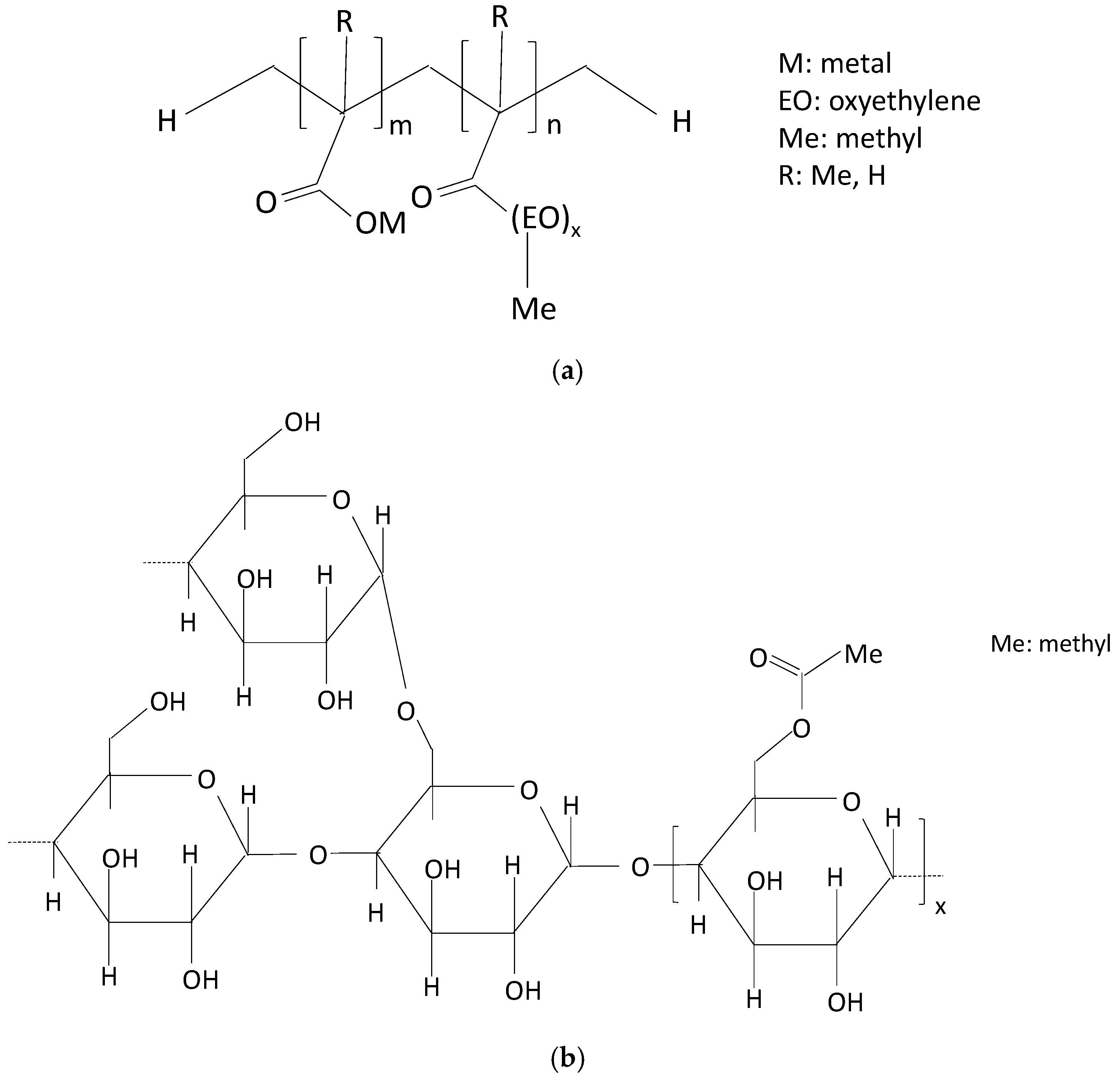

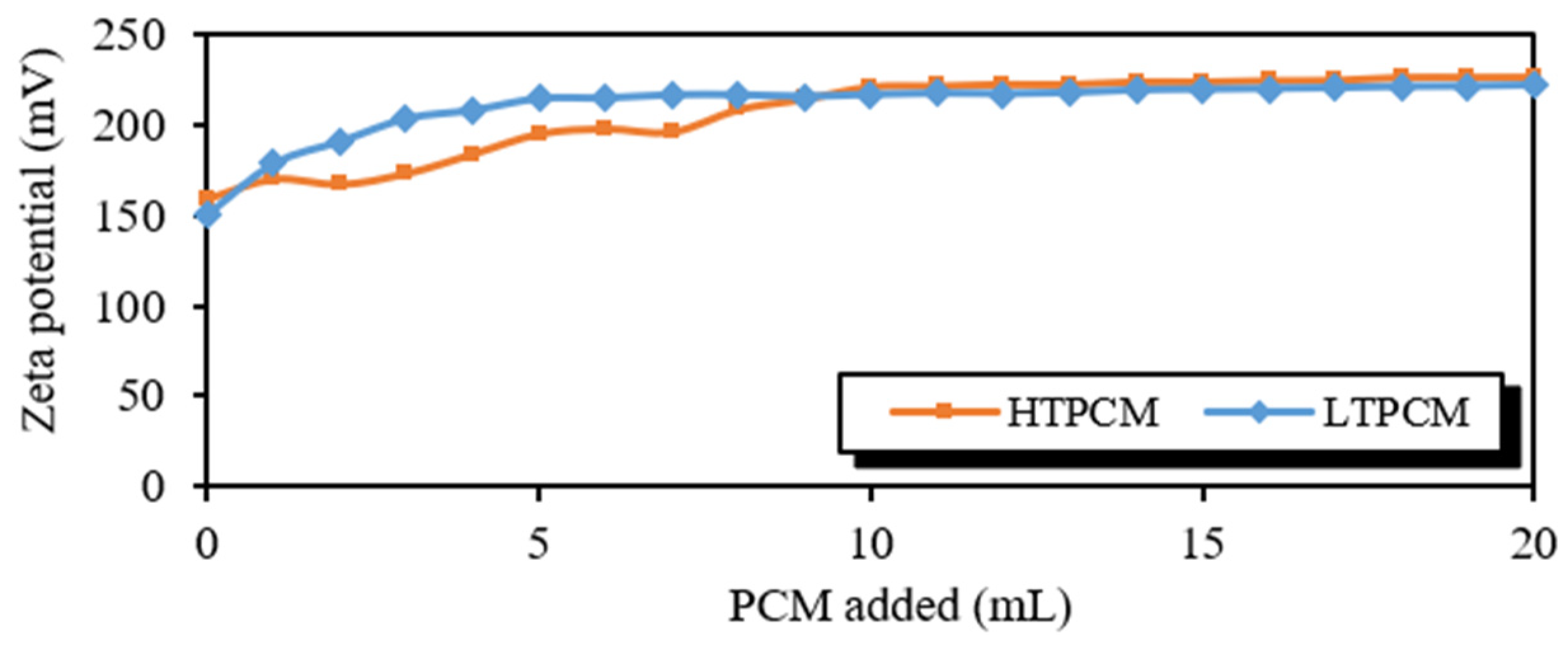

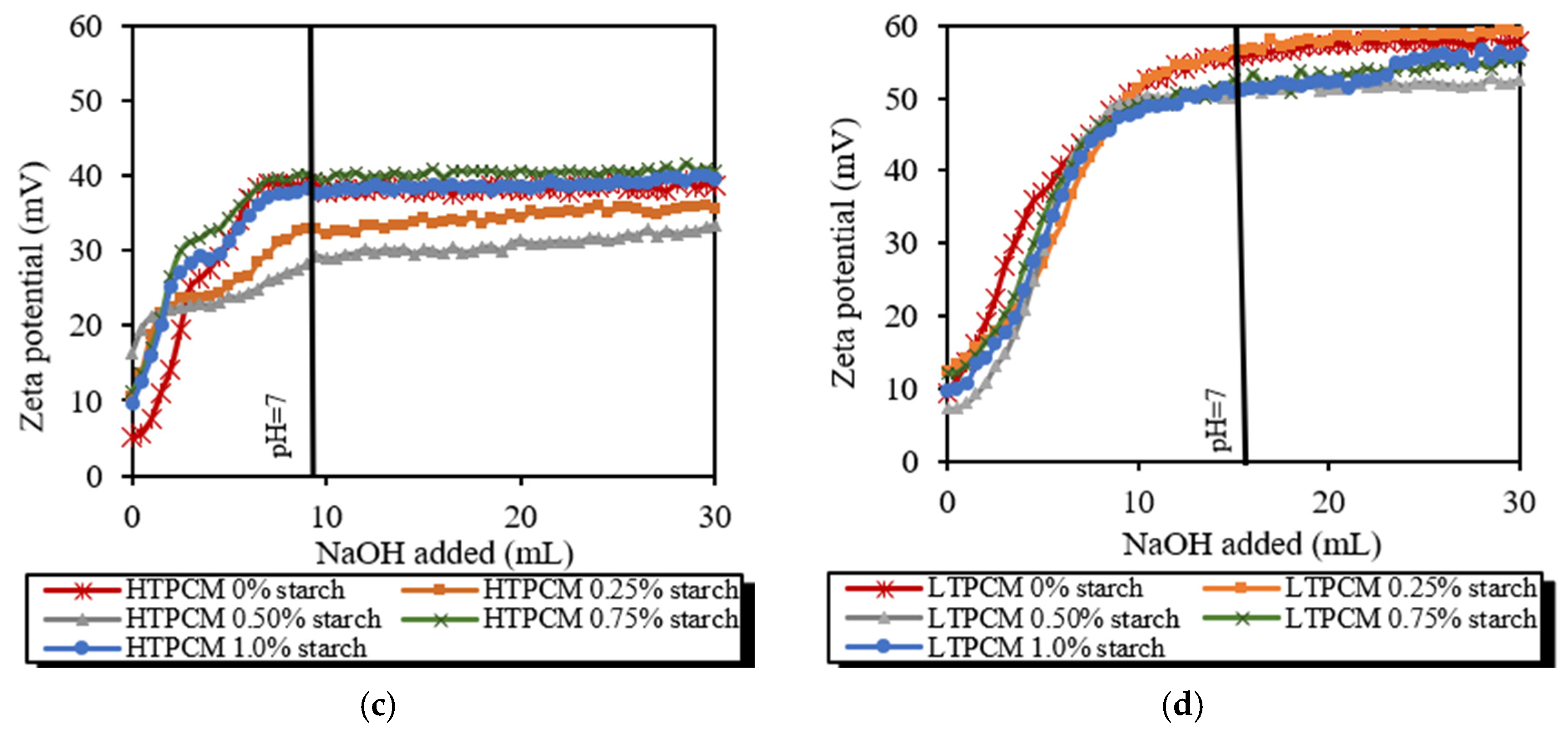
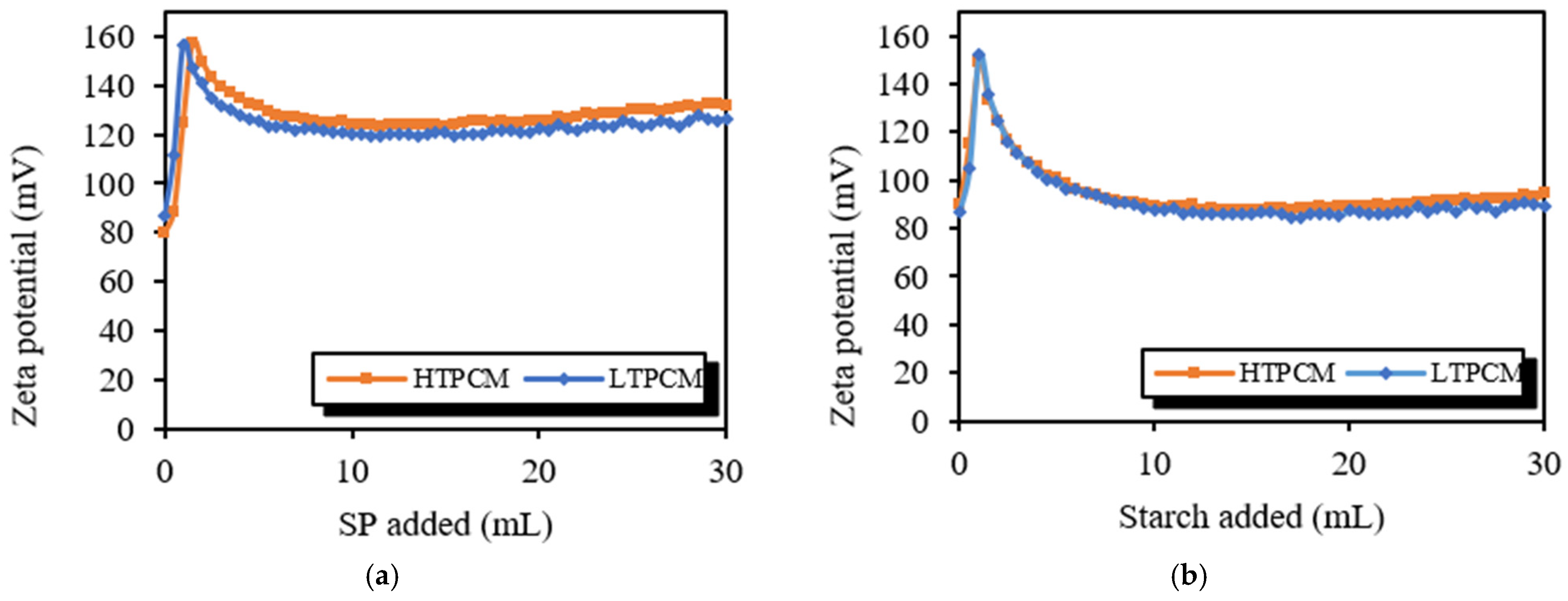


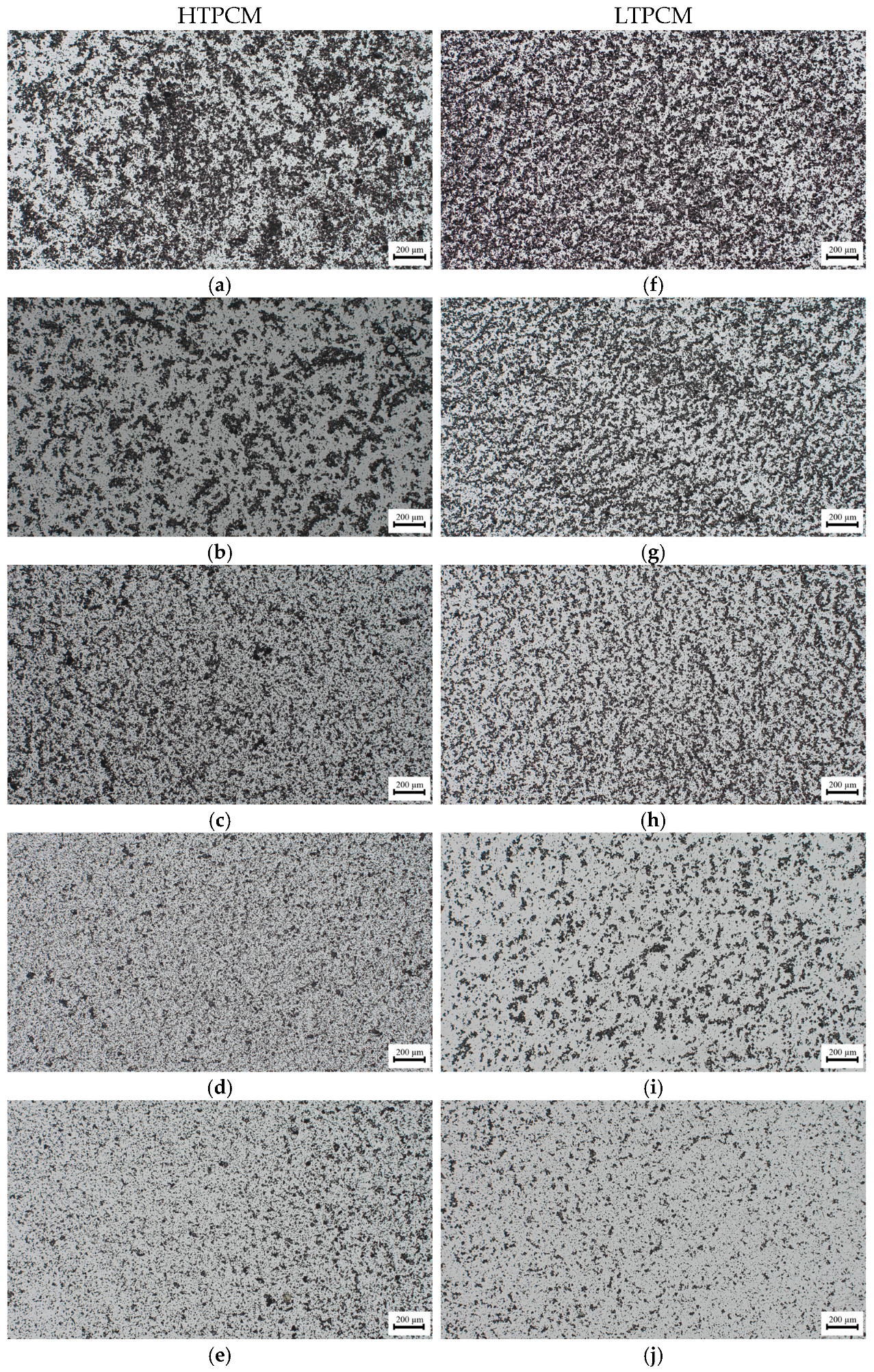

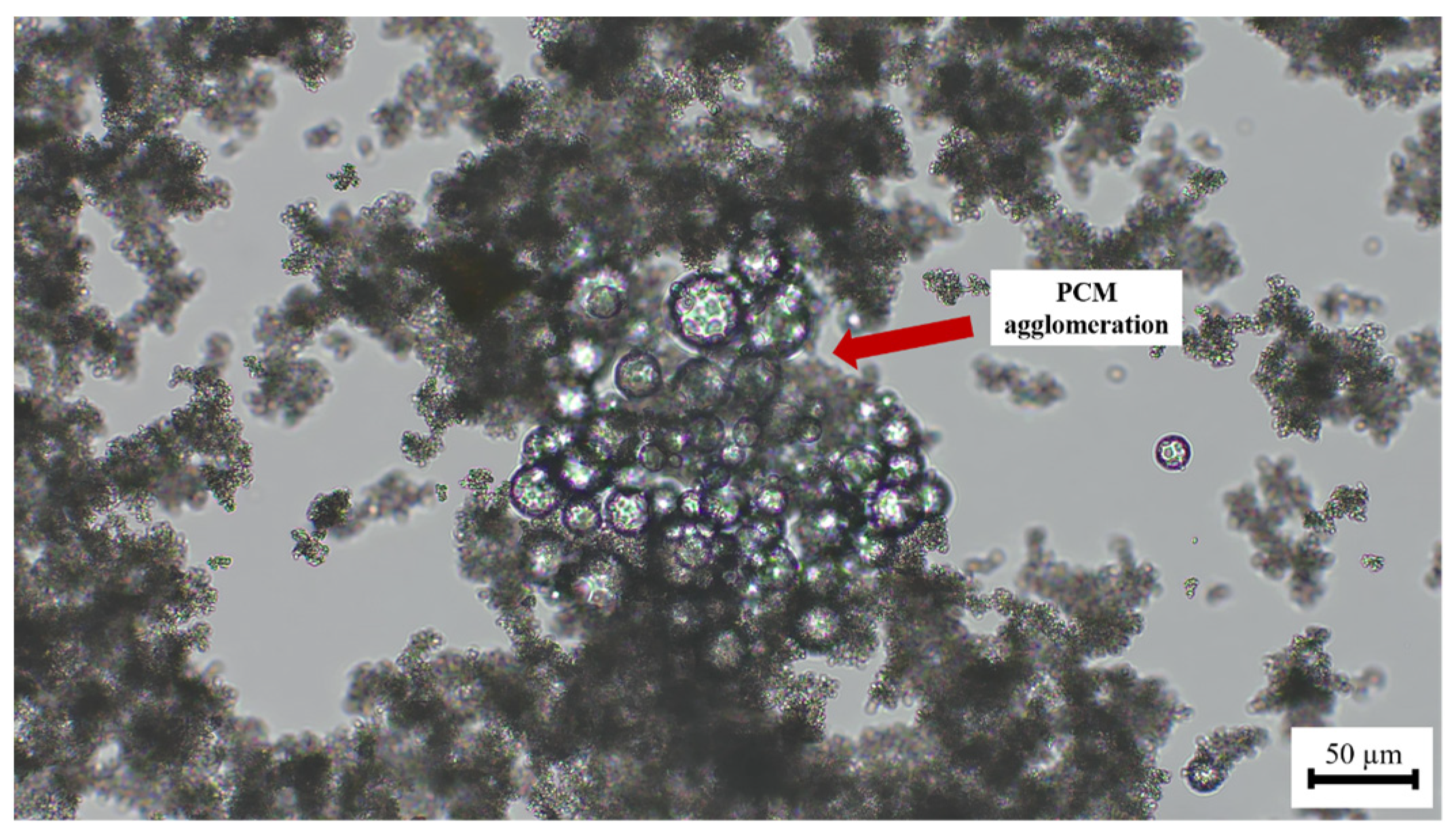

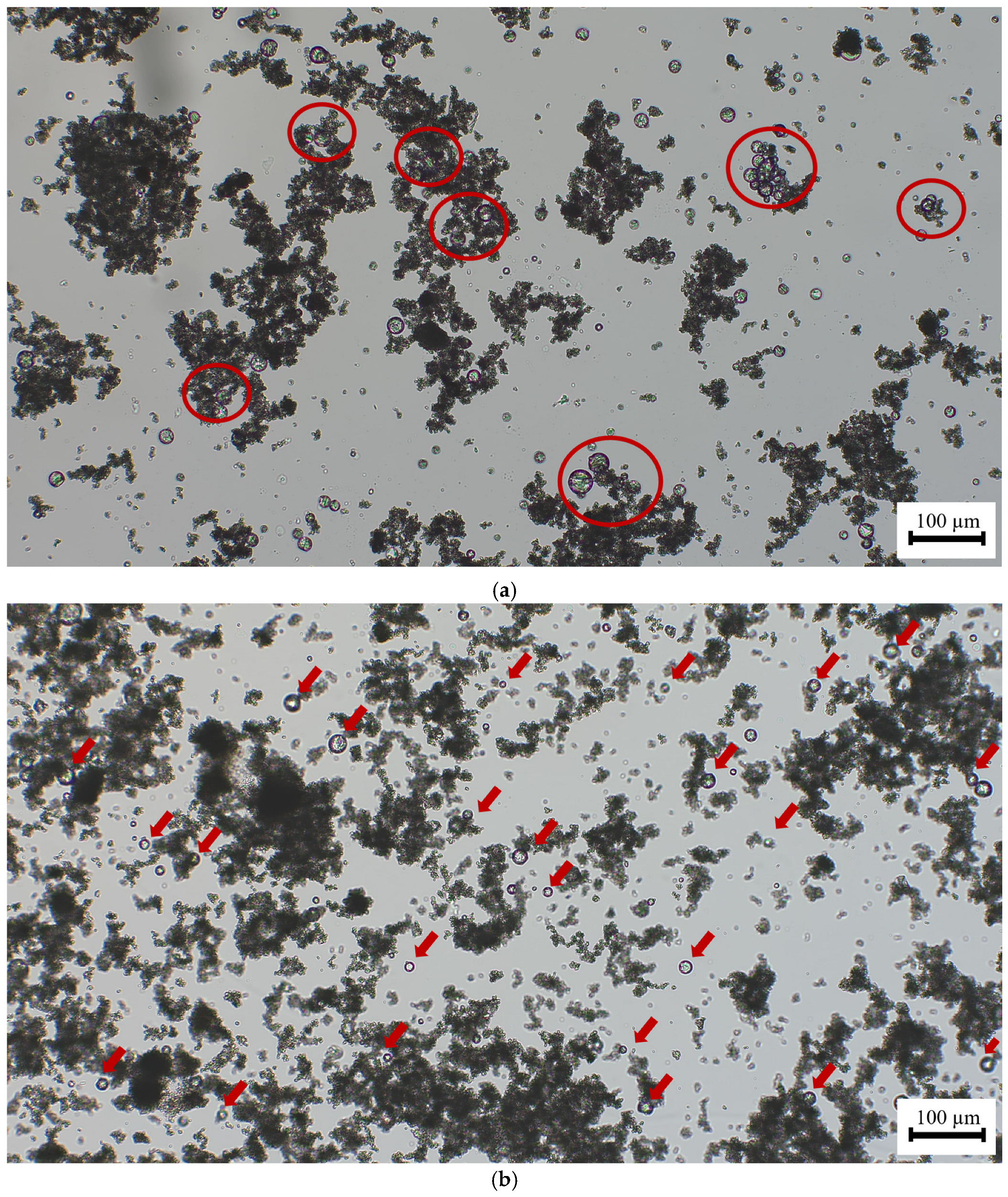
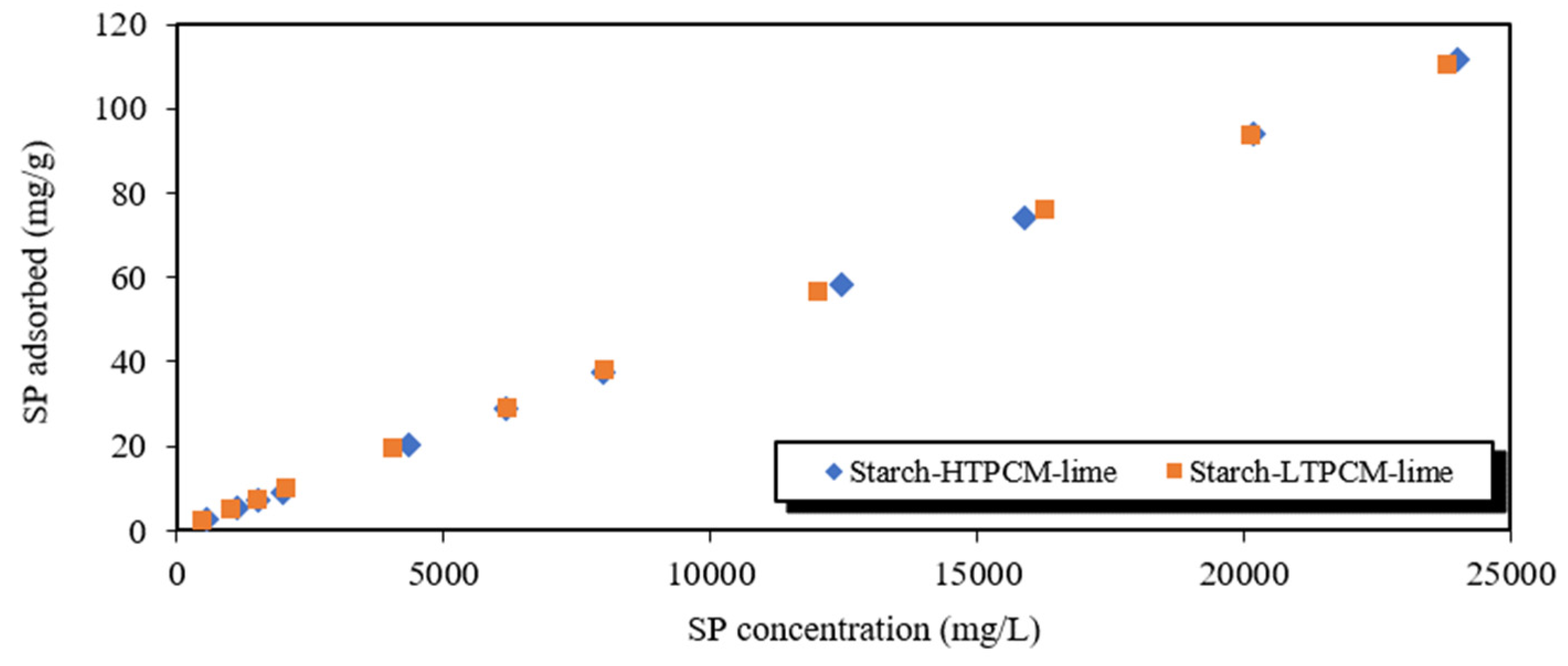
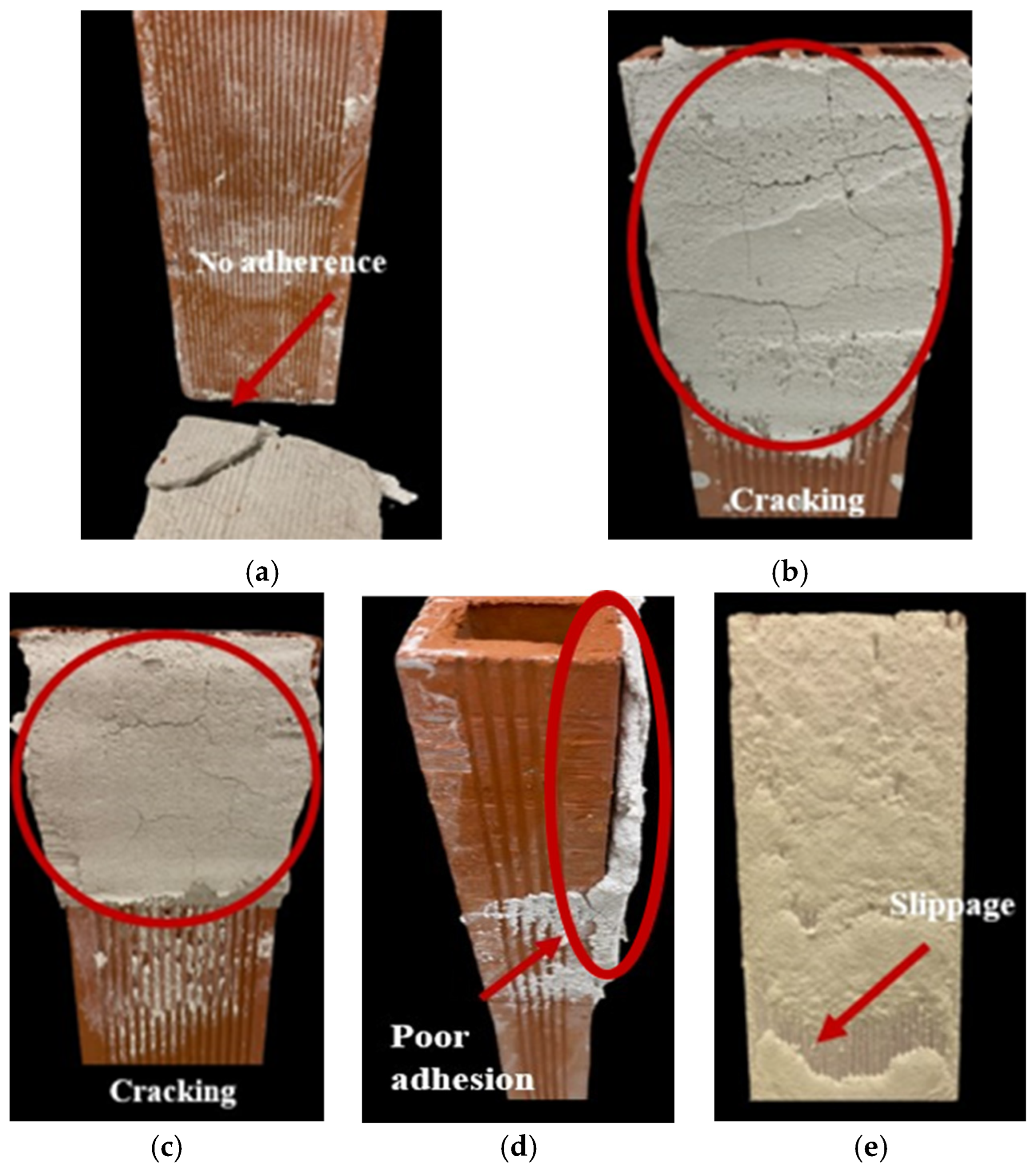

| SP (% bwol) | Apparent Viscosity (mPa·s) | Starch (% bwol) | Apparent Viscosity (mPa·s) | |
|---|---|---|---|---|
| HTPCM | 0.00 | 422 | 0.00 | 422 |
| 0.75 | 198 | 0.75 | 10,720 | |
| LTPCM | 0.00 | 2690 | 0.00 | 2690 |
| 0.75 | 1644 | 0.75 | 11,850 |
| Starch (% bwol) | SP (% bwol) | Apparent Viscosity (mPa·s) | |
|---|---|---|---|
| HTPCM | 0.50 | 0.00 | 11,660 |
| 0.50 | 0.50 | 4763 | |
| LTPCM | 0.50 | 0.00 | 3297 |
| 0.50 | 0.50 | 2275 |
| Langmuir | Freundlich | |||||
|---|---|---|---|---|---|---|
| qm (mg/g) | b (L/mg) | R2 | K | 1/n | R2 | |
| HTPCM | 6591.6 | 7.16 × 10−7 | 0.8133 | 0.00486 | 0.9958 | 0.9999 |
| LTPCM | 4578.5 | 1.03 × 10−6 | 0.9673 | 0.00494 | 0.9941 | 0.9999 |
| Render | LTPCM (% bwol) | HTPCM (% bwol) | SP (% bwol) | Starch (% bwol) |
|---|---|---|---|---|
| REF-1 | - | - | 0.60 | 0.50 |
| HTPCM-1 | - | 5 | 0.75 | 0.50 |
| HTPCM-2 | - | 10 | 0.75 | 0.50 |
| HTPCM-3 | - | 20 | 0.75 | 0.50 |
| LTPCM-1 | 5 | - | 0.75 | 0.50 |
| LTPCM-2 | 10 | - | 0.75 | 0.50 |
| LTPCM-3 | 20 | - | 0.75 | 0.50 |
| Render | Slump (mm) | Stiffening Time (min) | Paste Density (kg/L) | Entrained Air (%) | Water Retentivity (%) | Qualitative Evaluation of Rendering (0–3) |
|---|---|---|---|---|---|---|
| REF-1 | 182 | 1157 | 1.94 | 4.3 | 95.9 | 3 |
| HTPCM-1 | 177 | 1211 | 1.83 | 6.3 | 95.2 | 3 |
| HTPCM-2 | 175 | 1392 | 1.85 | 7.0 | 93.1 | 3 |
| HTPCM-3 | 161 | 1432 | 1.79 | 7.0 | 92.2 | 3 |
| LTPCM-1 | 178 | 1119 | 1.95 | 2.2 | 93.5 | 3 |
| LTPCM-2 | 189 | 1580 | 1.93 | 1.7 | 92.3 | 3 |
| LTPCM-3 | 183 | 1769 | 1.89 | 1.1 | 93.1 | 2 |
Disclaimer/Publisher’s Note: The statements, opinions and data contained in all publications are solely those of the individual author(s) and contributor(s) and not of MDPI and/or the editor(s). MDPI and/or the editor(s) disclaim responsibility for any injury to people or property resulting from any ideas, methods, instructions or products referred to in the content. |
© 2024 by the authors. Licensee MDPI, Basel, Switzerland. This article is an open access article distributed under the terms and conditions of the Creative Commons Attribution (CC BY) license (https://creativecommons.org/licenses/by/4.0/).
Share and Cite
Rubio-Aguinaga, A.; Fernández, J.M.; Navarro-Blasco, Í.; Álvarez, J.I. Study on the Interaction of Polymeric Chemical Additives with Phase Change Materials in Air Lime Renders. Polymers 2024, 16, 1121. https://doi.org/10.3390/polym16081121
Rubio-Aguinaga A, Fernández JM, Navarro-Blasco Í, Álvarez JI. Study on the Interaction of Polymeric Chemical Additives with Phase Change Materials in Air Lime Renders. Polymers. 2024; 16(8):1121. https://doi.org/10.3390/polym16081121
Chicago/Turabian StyleRubio-Aguinaga, Andrea, José María Fernández, Íñigo Navarro-Blasco, and José Ignacio Álvarez. 2024. "Study on the Interaction of Polymeric Chemical Additives with Phase Change Materials in Air Lime Renders" Polymers 16, no. 8: 1121. https://doi.org/10.3390/polym16081121






